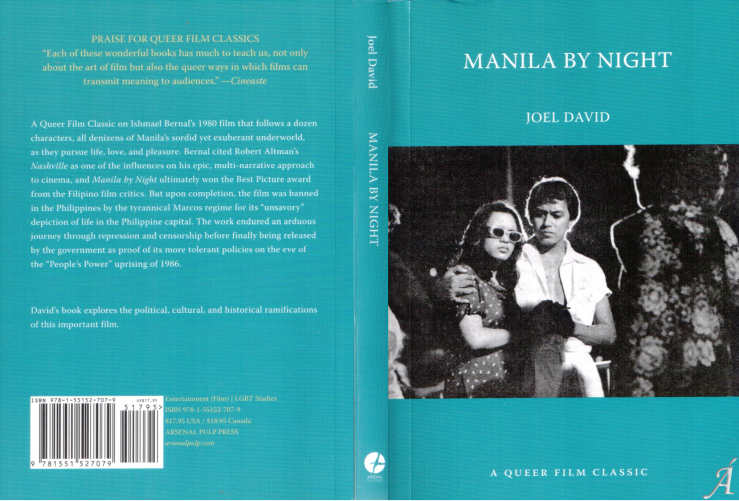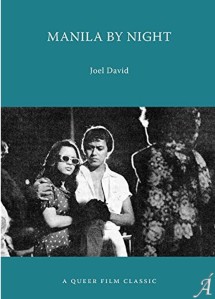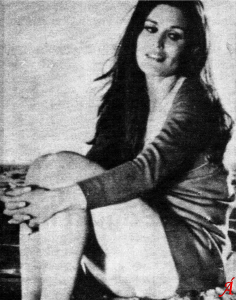Click on image to enlarge cover pic.
To order from the publisher, please click here.
To access the corrigenda & links to problematics, please click here.
From the INTRODUCTION (pp. 17-24):
As soon as I started the professional life that I had yet to fully chart, Manila by Night was ready to mark my steps. I had just completed the first of two bachelors degrees at the University of the Philippines (declared the national university in 2008), but my preparation for a career in journalism did not work out as I (and my circles of friends) thought it would. The anti-dictatorship movement I had participated in prescribed a brand of Marxism that I later learned went by a few names, with “orthodox” being the less-offensive term. I decided to distance myself from the political and economic analyses on which I’d built my name as a campus journalist, and focused on cultural reporting. My internships also alerted me to the existence of values that I knew I could never take seriously – the cultivation of sources (the more exclusive or exceptional, the better), for example, and the drive to out-scoop everyone else. I decided to give freelancing a shot, and when I couldn’t shape a sufficiently interesting story out of a cultural (usually film) event, I’d turn in a review instead.
11011By late 1979, I’d made enough of a buzz to be invited to the award-giving film critics circle. I also heard of a movie about Manila nightlife – which I’d been discovering on my own as a restless, hyperactive insomniac. When I was invited to a preview of Manila by Night, I was stunned to discover a lot of the personalities, locales, and lingo that I’d familiarized myself with since college. It was like I didn’t have to wait until nightfall any longer: I could just step into the screen, and that would be the city I had come to know. It wasn’t a pretty sight, but it was electric, erotic, vulgar, violent, dangerous, and loving, all in ways that the US-supported and Catholic Church-sanctioned dictatorship of Ferdinand E. Marcos would find embarrassing, if not outright immoral. It was too good to be untrue, so to speak, so I resolved to watch it as often as I could in case the regime decided to destroy all existing copies and consign the film to oblivion.
11011Which nearly came to pass. Before I could arrange to watch another preview, news came out that the movie had been banned by the then-militarized Board of Censors for Motion Pictures, a body that had tussled with Manila by Night director-writer Ishmael Bernal a few times already for too-earthy sex scenes in his previous films. “No worries,” said those in charge of the film, since the movie would be making its debut in an international venue anyway, having just been personally selected by Moritz de Hadeln to compete at the Berlin International Film Festival. Bernal, whom I’d met as a critics circle member, provided me with cassette tapes on which a playback of the audio track was recorded, with instructions to transcribe the dialog and provide a literal translation to be used as a guide by the German subtitler. The tapes were low-end, obviously second-hand, and I had to return them right after using them; if I’d known they would be the source of the only available “integral” version of the film, I would have asked for a better recording. A “where-are-they-now” epilogue was also hastily assembled by the producers for the Berlinale screening, to mollify the censors by making the claim that the intransigent characters were punished while the rest became upright citizens worthy of Ferdinand Marcos’s “New Society.”
11011After I turned in my work, a grapevine report circulated in film circles, about Imelda Marcos, with her typical flair for the dramatic, watching the movie and breaking down afterward. Everyone’s worst fear was confirmed: the movie would remain in limbo until the First Lady could be persuaded otherwise. I requested the copy of the transcription I made from Bernal so it could be printed, “uncensored,” in the March 1981 issue of The Review, a now-defunct monthly periodical in which I wrote and occasionally edited special issues. In November 1980, a few months before the script came out, the movie itself was approved for local release, with a four-page censors’ permit – the longest that had ever accompanied a Philippine screening. Since all mention of “Manila” (dubbed “City of Man” by the increasingly unstable Imelda) was disallowed, the movie’s title was changed to City after Dark.
11011The deliberation session for the critics’ annual awards was understandably turbulent. Along with a few other members, I insisted that any recognition given to City after Dark would be tantamount to validating what the censors had done. This resulted in a surprising inconsistency in the awards results, including a win for Best Picture but a loss for Best Director (one senior member mentioned that Bernal deserved to be “taught a lesson” regarding the lack of surface polish in his work). The logic was certainly bizarre – if the mangled version of the film deserved to win, then its strength derived primarily from its directorial virtues. From this point onward I began to question the Hollywoodian logic behind the critics’ awards activities, and have since sworn to premise my critical output on the assumption that, among other things, their earlier methods of multiple screenings and intensive deliberations may be useful, but their divisive, formalist, and canonical social-realist approach to award-giving deserved nothing but condemnation, if not contempt.
11011Meanwhile, the publicity team behind Manila by Night continued to conduct previews of the uncensored version – and I continued to attend as many of them as I could. I’d seen Robert Altman’s Nashville (1975), Bernal’s takeoff text, during its week-long run in Manila, and began paying close attention to attempts by other filmmakers, as well as by Bernal himself, to replicate this specific approach to the multiple-character film narrative. Despite the trauma experienced by Manila by Night, the multicharacter film format succeeded so well that it became a recognizable and distinct genre in Philippine film practice, with filmmakers (and a few critics) describing its samples as “milieu movies” and producers as well as talent managers introducing new faces in batches meant to appear as equal lead performers in as many film projects as they could sustain.
11011A few years later, the anti-dictatorship movement began to pose a serious challenge to Ferdinand Marcos’s presidency. I was working at the Experimental Cinema of the Philippines (ECP), the government film agency, and was surprised by the ease by which I was able to circulate a request to screen Manila by Night (not City after Dark) and process the paperwork for its release. The agency also assigned me to complete the then newly introduced undergraduate film program at the national university. Even before the people-power uprising of February 1986, the ECP was dissolved, but my new degree enabled me to start teaching as an instructor, and eventually helped me wangle a Fulbright grant for graduate studies in the US. My doctoral dissertation dealt, predictably enough, with the multicharacter film format.
11011During my last trip to Manila, I had an informal discussion with Bernal (a mini-interview of sorts), and managed to extract from him a promise to sit for an interview for my dissertation on multicharacter cinema. I told him I’d be drafting a set of questions and would send them to him before my next trip home. While I was away, he passed away from cerebral aneurysm, joining the legendary realm where Manila by Night continues to flourish. I decided to forgo all trips outside the US until I had completed my dissertation. My residency deadline was looming, and I was hastily drafting my manuscript on September 11, 2001, when my parents called to ask if everything was all right. The first tower crashed right after I turned on the television, and from that point on I knew that returning to the Philippines might not be the best option, but it was the only definite line of action that would be open to me in the near future. Bernal had been gone for over half a decade, and Philippine cinema was about to abandon celluloid production and embrace the digital era for good.
From ACKNOWLEDGMENTS (pp. 9-10):
Profuse thanks to Patricio N. Abinales, Thelma E. Arambulo, Tina Baluyut, Joey Baquiran, Vicky Belarmino, Bernardo Bernardo, Pete Bilderback, Karen Blackstein, Marivic Buquis-Tjardes, Flor Caagusan, Patrick F. Campos, Veronica Caparas, Robert Cerda, Mel Chionglo, Leloy Claudio, Sylvia Estrada Claudio, Divine Go David, Gigi Felix-Velarde David, Jek Josue David, Nestor de Guzman, Nicolo del Castillo, Archie del Mundo, Lizbeth de Padua, Jojo Devera, Cynthia Estrada, Patrick D. Flores, Peque Gallaga, Alfredo Garcia, Melanie Joy C. Garduño, Paul Grant, Ju-Yong Ha, Maurine Haver, J. Pilapil Jacobo, Marne Kilates, Ricardo Lee, Bliss Cua Lim, Sergio Lobo, Jo-Ann Q. Maglipon, Juan Miguel Manansala, Gina Marchetti, Ibarra Mateo, Joe McElhaney, Toby Miller, Carla Montemayor, Roselle Monteverde, Jude Ortega, Ellen Ongkeko-Marfil, Ellen J. Paglinauan, Vanessa Pallarco, Haesuk Park, Inkyu Park, Shin-gu Park, Sybil Jade Peña, Elwood Perez, Theo Tisado Pie, Benjamin Pimentel, Ethel Pineda, Jane Po, Rowena Raganit, Winston Raval, Lore Reyes, Ramon Reyes, Roselle Leah K. Rivera, Ninotchka Rosca, Filomeno S. Sta. Ana III, Angela Stuart Santiago, Aida Santos, Bayani Santos Jr., Teresita Santos, Ophelia Miller Segovia, Vincenz Serrano, Minsun Shim, Irene Balucos Sia, Boemshik Son, Robert Sklar, Francis Sollano, Robert Stam, Lauren Steimer, Chris Straayer, Lulu Torres-Reyes, Mauro Feria Tumbocon Jr., Violeda A. Umali, Charmian Uy, JC Velasquez, Taeyun Yu, Jovy Zarate, and Zhang Zhen.
11011I’ve been fortunate to work with some outstanding editors in the past, but with Matthew Hays and Thomas Waugh, I saw my early manuscript shape-shift in ways I couldn’t always anticipate, with the revised version always a new text whose acquaintance I was happy to make. They’ve been at this task for nearly a decade, without any remuneration, so while I imagine that the impending end of the Queer Film Classics series may be a relief of sorts, it would also open up a gap that other people ought to consider filling. Publishers Brian Lam and Robert Ballantyne, editors Susan Safyan and Tara Nykyforiak, and designer Oliver McPartlin are also part of the series, and while I interact mainly with professors Waugh and Hays, I occasionally correspond with the other participants in the project; as the book begins to take final shape, I can only be grateful that their commitment is just as complete and indispensable. (Portions of this manuscript have appeared in my articles in Kritika Kultura and Plaridel.)
Library and Archives Canada CIP
David, Joel, author
11011Manila by Night : a queer film classic / Joel David.
(Queer film classics)
Issued in print and electronic formats.
ISBN 978-1-55152-707-9 (softcover). – ISBN 978-1-55152-708-6 (HTML)
110111. Manila by Night (Motion picture). 2. Bernal, Ishmael – Criticism and interpretation. I. Title. II. Series: Queer film classics
PN 1997.M363D38 20171101791.43’721011C2017-906836-9
PN 1997.M363D38 20171101791.43’721011C2017-906837-7
Contents of the Queer Film Classics Edition
© 2017 by Joel David & Arsenal Pulp Press; All Rights Reserved
PRELIMINARIES
Title Page; Copyright; Table of Contents; Dedication: For Ishmael Bernal (1938-96); Acknowledgments; Synopsis; Credits; Introduction (1-24)
BODY TEXT
Chapter I. Manila by Day: Fifty Years of Hollywood (25-69)
Movies and the Philippines
Master’s Tool
Language without Words
“Ishma” and Manila by Night
The Origin of Manila by Night
Controversies
The Berlinale Connection
The Other Manila Movie
Sidebar: A Pinoy Queer-Cinema Mini-Canon (70-75)
Chapter II. Manila by Night: City of Mania (76-115)
Many-Peopled Narratives
The Philippine Moviegoer
A Perverse Approach
Technique as Politics
Voyeuristic Restlessness
The Queering of Technique
The Mirror Effect
Sound Logic
Wow and Flutter
Sidebar: A Multicharacter-Movie Supplementary List (116-119)
Chapter III. Beyond Manila: Cinema & Nation in Crisis (121-158)
Locale as an Entity
Babies and Beauties
Triangulations
The Multicharacter Movie Genre
Road Not Taken
Milieu Realism
A “Straight” Way Forward
Gender Types
The Other(ed) Queer Character
Radical Potential
END MATTER
Conclusion; Appendix: Manay Revisits Manila by Night: An Interview with Bernardo Bernardo; References; Filmography & Theater Productions; Index; About the Author; About the Editors; Titles in the Queer Film Classics Series (159-208)
RELATED LINKS
- A special folio on the film now opens this blog’s Extras section.
- Corrigenda for this specific edition are available here, while a discussion of the text’s problematics, originally incorporated in the corrigenda page, has been expanded and separated out, with one for textual issues and another for illustrational issues.
- To read the book lecture “Queerness as Defiance in Manila by Night,” please click here.
- For a detailed storyline originally drafted for this book, please click here.
REVIEWS IN JOURNALS
(in chronological order)
Josen Masangkay Diaz, “Third Cinema, Queer Technique, and Manila’s Multiple Characters,” Jump Cut: A Review of Contemporary Media 59 (Fall 2019).
Ronald Baytan, “On Bernal’s Homage to Manila: A Review of Joel David’s Manila by Night: A Queer Film Classic,” Plaridel: A Philippine Journal of Communication, Media, and Society 16.2 (December 2019).
Chuckberry J. Pascual, “Mahalaga ang Marami: Rebyu ng Manila by Night: A Queer Film Classic ni Joel David,” Pelikula: A Journal of Philippine Cinema 5 (2020); click here for the English translation.














 ORCID ID
ORCID ID 